Introduction
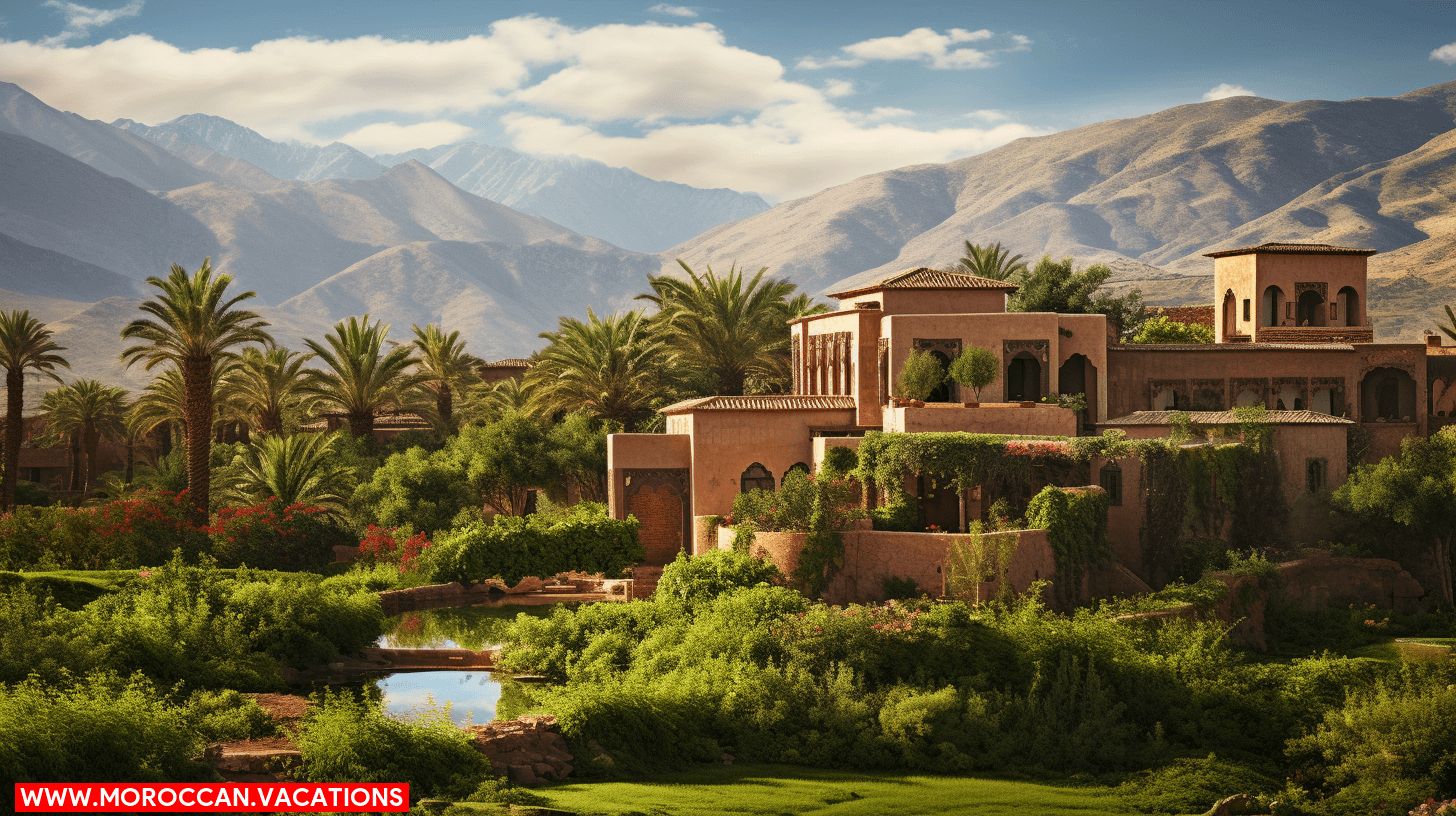

Imagine yourself navigating the bustling souks of Marrakech, the balmy breeze a stark contrast to the snowy peaks of the Atlas Mountains looming nearby. You’re about to dive deep into Morocco’s diverse climate, a key to unlocking the treasures of this vibrant country. You’ll learn how each season shapes your experience, from spring’s mild whispers to summer’s fervent song. Get ready for an authoritative guide tailored to your wanderlust, ensuring your Moroccan adventure is nothing short of extraordinary.
You’ll discover that Morocco’s climate complexity is the product of its unique geographical tapestry. The interplay of the Atlantic Ocean, the Mediterranean Sea, and the vast Sahara Desert has shaped historical weather patterns, creating a climate mosaic that demands attention. As you delve into Morocco’s climatic intricacies, you’ll find that geographic influences are paramount. The coastal regions enjoy a temperate climate with a mild, wet winter influenced by the Atlantic, while the Mediterranean imparts a warmer, drier character to the northern coast.
Inland, the towering Atlas Mountains act as a weather barrier, dictating local adaptation strategies and contributing to the stark contrasts in seasonal variations. Here, winters can be harsh with snow-capped peaks, whereas summers are hot and dry. The proximity to the Sahara brings about hot, dusty winds that can sweep across the landscape, altering both daily life and tourist activities.
Climate change looms over these historical patterns, subtly shifting the dynamics of Morocco’s weather. You’re witnessing a gradual increase in temperatures and changes in precipitation, which are influencing everything from agricultural practices to the availability of water resources.
Understanding these changes is crucial for weather forecasting, a tool that not only informs local adaptation but also guides the expectations and preparations of visitors. As a lover of freedom, you’ll appreciate the ability to navigate Morocco’s diverse climates with the foresight that accurate forecasting provides. Engaging in tourist activities, from trekking in the Atlas Mountains to exploring desert dunes, becomes a more enriching experience when you’re attuned to the seasonal cadences and prepared for what the elements may present.
Spring Climate
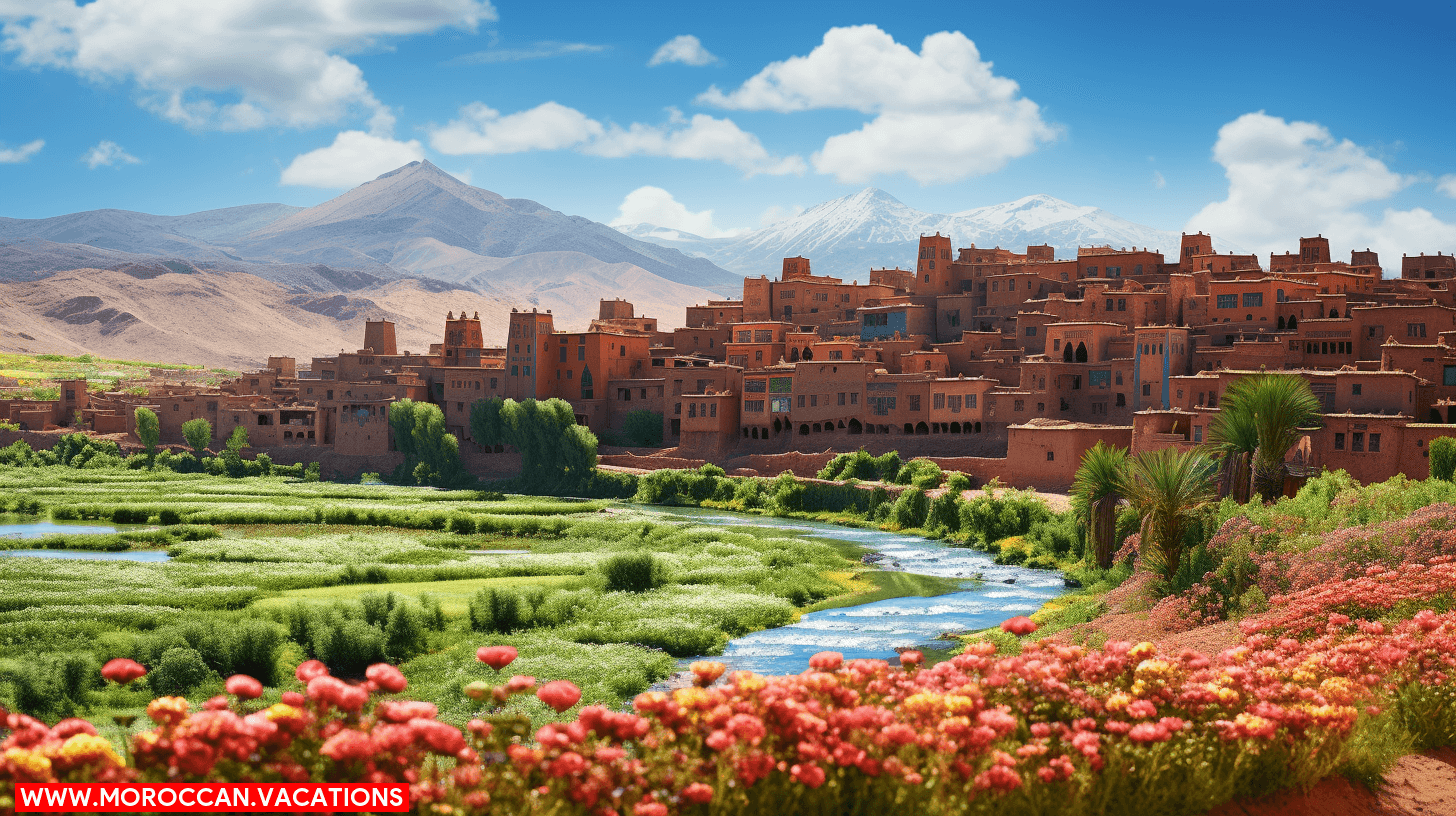

Spring in Morocco ushers in a season of transformation, as you witness the landscape bloom with temperate weather before the summer heat sets in. This is a time when the average temperatures are pleasantly mild, with days typically ranging from 15°C to 25°C (59°F to 77°F), although nights can still be cool. You’ll find the climate varying by region, with coastal areas being cooler and the interior, particularly the desert, experiencing more dramatic shifts between day and night temperatures.
Analyzing the spring climate further:
- Average temperatures
- Coastal cities like Casablanca and Tangier offer breezy and moderate weather.
- Inland destinations, such as Marrakech and Fes, present warmer days, perfect for soaking up the sun.
- Rainfall patterns
- Expect sporadic showers, which are often brief and followed by clear skies.
- The Atlas Mountains can have more persistent rain, replenishing the green valleys.
With spring’s arrival, flower blossoming is in full sway, creating a picturesque setting for various outdoor activities. Hiking trails in the Atlas Mountains become particularly inviting as the snow begins to melt.
As for festivals and events, spring is a culturally rich season. You might time your visit to coincide with the renowned Fez Festival of World Sacred Music, which symbolizes the freedom and harmony that you seek.
For clothing and packing tips, layering is key. Pack light jackets for the evenings and comfortable attire for daytime exploration.
Best destinations in spring include:
- Chefchaouen, with its stunning blue-washed buildings, is even more enchanting amidst the mild weather.
- The rose valleys near Ouarzazate, where roses are in full bloom, creating a sensational backdrop for your journey.
In spring, Morocco beckons with open arms, promising freedom, beauty, and an unforgettable climate experience.
Summer Climate
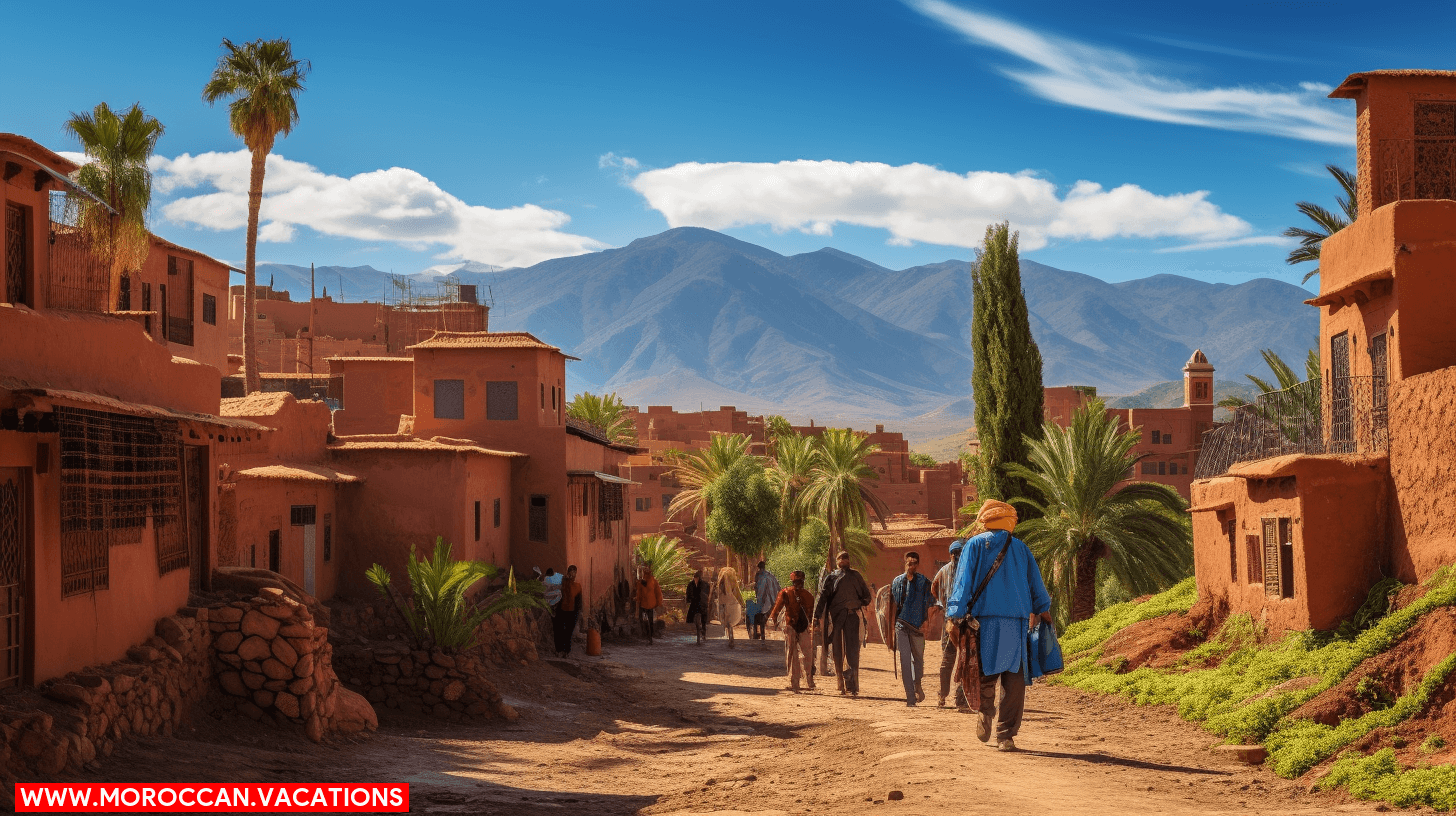

As you venture into Morocco’s summer months, you’ll encounter a climate that shifts from warm to scorching, especially in the interior and desert regions. During this time, the nation grapples with heatwaves and droughts, a clear signal of the intensity of the Moroccan summer. High temperatures regularly soar above 40°C (104°F), and the arid air exacerbates the sensation of heat. These scorching summers necessitate a rigorous approach to hydration and sun protection, making sunscreen essentials non-negotiable for anyone stepping outside.
In contrast, the coastal areas offer a reprieve, where beach weather prevails, and the Atlantic breezes temper the searing heat, making it an idyllic time for sun-seekers to bask along the shores. The dichotomy between the coast and inland areas is stark, with the latter experiencing prolonged dry spells that can challenge even the hardiest traveler.
For those looking to embrace outdoor activities, early morning or evening hours are the most advisable times to explore. Whether trekking through the Atlas Mountains or wandering through ancient medinas, planning is crucial to avoid the midday sun. The Moroccan summer demands respect for its natural extremes; it’s a season where freedom lies in the ability to navigate its challenges with informed choices and preparedness.
Autumn Climate


Transition marks the arrival of autumn in Morocco, where you’ll experience a gradual cooling from the summer’s peak temperatures and the onset of sporadic rainfall. This season is characterized by a palpable shift in the atmosphere as the country’s diverse landscapes mirror the changing colors of autumn. The temperature range becomes more varied, with warm days giving way to cooler evenings, necessitating thoughtful clothing choices to navigate the fluctuating conditions comfortably.
Analyzing the autumn climate further, consider the following aspects that significantly shape your experience:
- Changing colors & Outdoor activities
- Hiking in the Atlas Mountains reveals a tapestry of rich, autumnal hues.
- Coastal regions offer mild weather, perfect for beach outings with fewer crowds.
- Rural areas burst into harvest colors, with olive and saffron fields dotting the landscape.
- Harvest season & Seasonal foods
- Markets overflow with the bounty of the harvest season, including dates and pomegranates.
- Seasonal foods like roasted root vegetables and hearty tagines become prominent in local cuisine.
- Vineyards are abuzz with activity, presenting an opportunity to participate in grape harvests.
- Fall festivals & Rainy days
- Celebrations like the Erfoud Date Festival mark the season with cultural exuberance.
- Rainy days, though sporadic, can impact travel plans, making it wise to prepare for sudden showers.
- Fall festivals provide a glimpse into Morocco’s rich traditions and the joy of communal gatherings.
As you plan your Moroccan journey, factor in these autumnal shifts. Embrace the freedom to explore the outdoors before winter sets in, partake in the cultural festivities, and indulge in the seasonal foods that make autumn in Morocco a feast for the senses.
Winter Climate
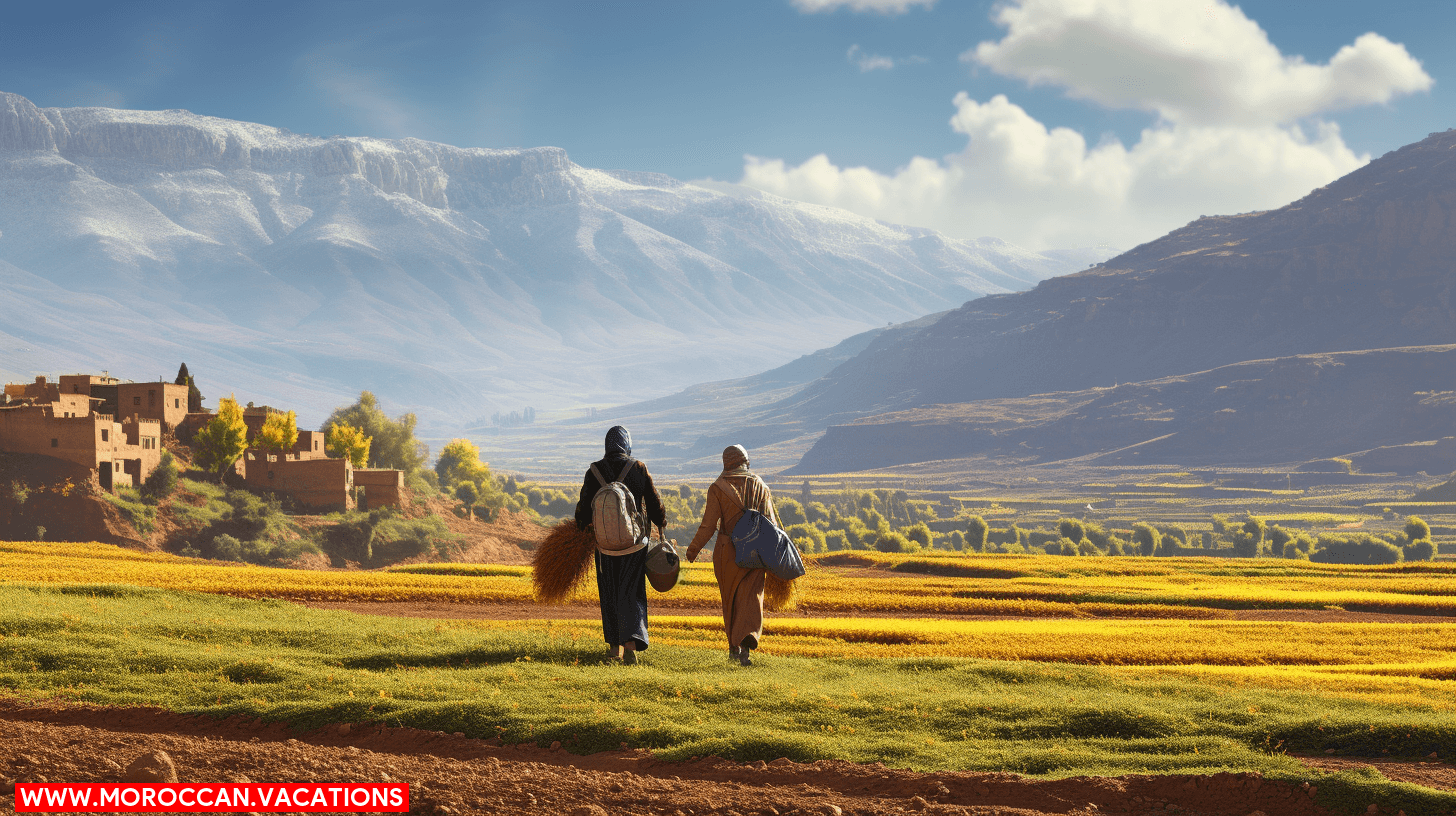

During winter, you’ll find Morocco’s climate transforms significantly, with snow-capped Atlas Mountains and pleasantly cool coastal cities. This seasonal shift offers a unique array of Morocco winter activities that cater to the adventurous spirit seeking freedom from the ordinary.
In the High Atlas, winter hiking is a sublime pursuit. With the right winter clothing in Morocco—think insulating layers and a reliable jacket—you can embark on treks to witness breathtaking panoramas and the quiet majesty of the snow-blanketed peaks. Experienced guides are essential for navigating, as conditions can be challenging, ensuring a safe yet exhilarating experience.
Moroccan winter festivals add a cultural dimension to your visit. These vibrant celebrations, such as the International Film Festival of Marrakech, provide insight into the rich tapestry of Moroccan heritage. Engaging with locals and fellow travelers alike, you’ll find the communal atmosphere to be both warming and liberating.
For wildlife enthusiasts, winter in Morocco is a chance to observe migratory birds and native species in less crowded settings. The quieter months allow for a more intimate connection with nature, whether you’re birdwatching in the wetlands or spotting Barbary macaques in the cedar forests.
Winter beach destinations in Morocco, such as Agadir, offer mild weather and uncrowded sands—a stark contrast to the bustling summer months. Here, freedom is found in the serene coastline and open spaces.
Lastly, winter food in Morocco is all about comfort and warmth. Traditional dishes like tagines and harira soup are not just nourishing, they’re an invitation to linger at the table, savoring the flavors and the company.
With a keen eye for detail and an appreciation for variety, your winter in Morocco can be as diverse and enriching as the landscape itself.
Climate Impact on Travel Planning


Understanding Morocco’s varied climate is crucial as you plan your travel itinerary to ensure you’re visiting each region at its prime. Weather considerations are the linchpin in determining the best times for outdoor activities, engaging in seasonal attractions, and experiencing the full splendor of cultural events and festivals.
- Weather Considerations
- Coastal areas offer mild temperatures year-round, perfect for beach activities.
- The Atlas Mountains can be quite cold in winter, ideal for skiing, but require caution during snowmelt in spring.
- The Sahara Desert is best visited in spring and autumn to avoid the extreme summer heat.
Packing essentials vary significantly with the climate zones; a down jacket may be necessary for the mountains, while light, breathable clothing suits the desert. Always include layers to accommodate the temperature swings from day to night.
- Outdoor Activities
- Trekking: Optimal in spring and autumn; pack sturdy boots and layered clothing.
- Surfing: Winter swells are best; include a wetsuit for cooler waters.
- Camel rides: More enjoyable outside the searing summer months; don’t forget sunscreen and a hat.
Climate-related health precautions are paramount. Hydrate frequently to combat dehydration, particularly in arid zones, and be mindful of altitude sickness in the highlands.
- Seasonal Attractions and Cultural Events
- Marrakech’s vibrant souks are year-round, but the city’s festivals are seasonal highlights.
- The Rose Festival in Kelaat M’Gouna is a spring delight.
- Avoid the fierce heat during Ramadan as many services are limited.
Lastly, climate change effects may alter traditional patterns, so stay informed on current conditions. Understanding these nuances enhances your freedom to explore Morocco’s diverse landscapes and rich culture with confidence and comfort.
Conclusion
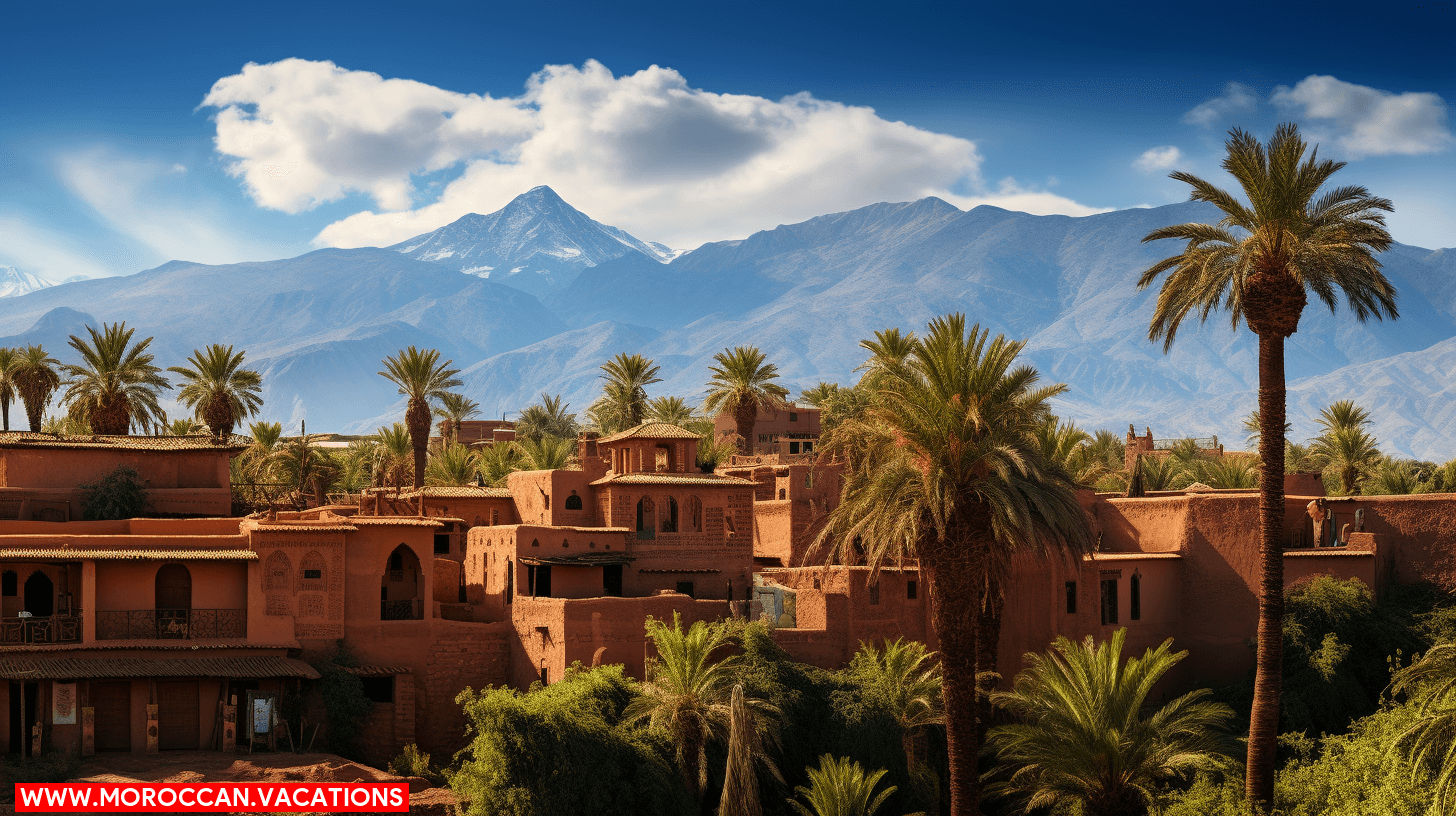

While considering Morocco’s climate zones and their impact on your itinerary, you’ll find that the country’s diverse weather patterns cater to a wide array of preferences and activities. The desert ecology, with its vast dunes and starlit nights, offers an otherworldly experience, but you must prepare for extreme heat during the day and significant drops in temperature after sunset. It’s crucial to respect these conditions to fully enjoy the desert’s unique allure.
Coastal weather, on the other hand, tends to be milder, with refreshing sea breezes tempering the warmth. The Atlantic and Mediterranean coasts provide a haven for those seeking to unwind by the water or engage in maritime pursuits. Mountain temperatures vary greatly, with the Atlas Mountains serving as a barrier that influences the country’s climatic divide. You’ll want to pack layers if you’re venturing into these elevations, where cooler conditions can provide a welcome respite from the urban heat of cities like Marrakech and Fez.
Rainfall patterns are another variable to consider, particularly if you’re interested in Morocco’s rich agricultural offerings. The variability of rain, especially in rural areas, can have profound agricultural effects, shaping the availability and variety of fresh produce you’ll encounter in local markets.
Urban heat is a tangible phenomenon in Morocco’s bustling cities, and understanding the local wind systems can offer relief. The Chergui, a hot, dry wind from the Sahara, can elevate urban temperatures, while the coastal Alizee brings cooler, moist air inland.
